

A blade server, often simply referred to as a “blade,” is a compact, self-contained server that slots into a chassis alongside other blades. This design contrasts with traditional rack servers, which are standalone units that take up a specific amount of rack space.
From space-saving designs to advanced security and enhanced connectivity, the right blade server can help you optimize your infrastructure investments and get the most from your data center. Here are our top picks for the best blade servers for 2023:
Whether you’re upgrading an existing data center or constructing a new one from the ground up, these servers are poised to be the frontrunners in cutting-edge data management and processing. Here’s a quick snapshot of the best blade servers in the market.
| Processor | Memory capacity | Storage options | Connectivity | Pricing | |
|---|---|---|---|---|---|
| HPE ProLiant BL460c | Intel Xeon E5-2600 v4 series or similar; Xeon Scalable | up to 4TB | SATA, SAS, NVMe | 10GbE, 20GbE, 25GbE, FC8, FC16, FlexFabric | Contact sales for custom pricing |
| Cisco UCS B200 M5 | Intel Xeon Scalable processors | up to 6TB | SATA, SAS, NVMe, M.2 | 10GbE, 25GbE, 40GbE, FC8, FC16, FCoE, VIC | Contact sales for custom pricing |
| Lenovo ThinkSystem SN550 V2 | Intel Xeon Scalable processors | up to 3TB | SATA, SAS, NVMe | 1GbE, 10GbE, 25GbE, FC8, FC16 | $4,000 and up, depending on model and configuration |
| Dell PowerEdge FX2 Chassis | Intel Xeon E5-2600 v4 series or similar | Chassis system; exact options depend on blade model | Chassis system; exact options depend on blade model | 10GbE, 40GbE, FC8, FC16 | Contact sales for custom pricing |
Jump to:

Best overall blade server solution
The HPE ProLiant BL460c is a blade server offering from Hewlett Packard Enterprise, recognized for its industry-leading performance, versatility, and energy efficiency. As part of HPE’s ProLiant line, the BL460c is tailored for enterprise environments, featuring top-tier compute capabilities in a space-saving form factor.
With its combination of processing power, memory scalability, and enhanced management features, the BL460c is designed to address the complex workloads and dynamic computing needs of modern businesses.
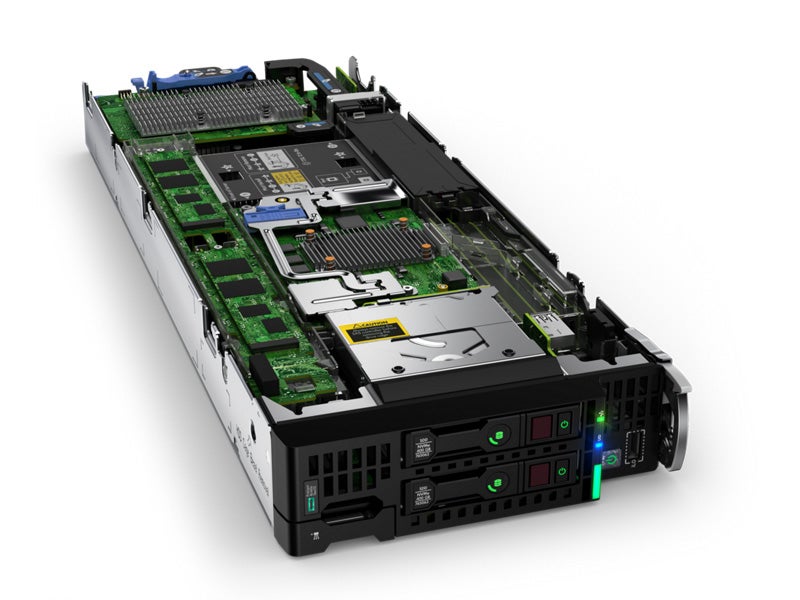
| Pros | Cons |
|---|---|
| With support for the latest processors, it delivers top-tier computing power. | Being a blade, it requires a specific HPE enclosure, potentially limiting flexibility. |
| Its blade form factor allows for a dense server configuration, optimizing data center space. | |
| Comes equipped with HPE’s integrated lights-out (iLO) management, facilitating remote server management. |

Best high-performance blade server solution
The Cisco UCS B200 M5 is a part of Cisco’s Unified Computing System (UCS) portfolio, renowned for blending performance, versatility, and density in a half-width blade form factor. Tailored to fit the needs of a wide range of applications and workloads, the B200 M5 boasts formidable compute capabilities, memory capacity, and storage flexibility.
Recognized for its integration capabilities within the UCS ecosystem, the B200 M5 stands as a testament to Cisco’s commitment to data center innovation and their drive to streamline and unify computing resources.
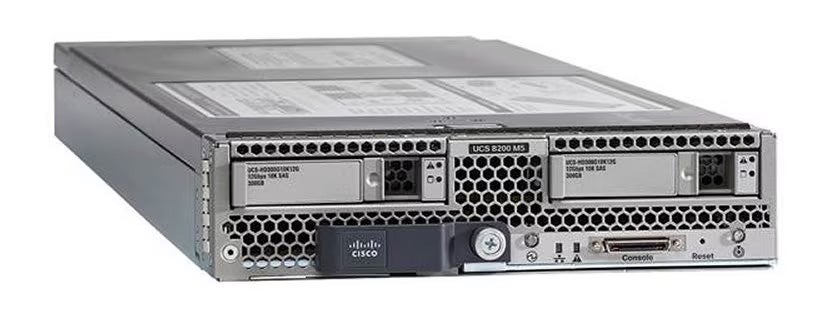
| Pros | Cons |
|---|---|
| Designed to handle a variety of workloads, from virtualization to database operations. | The blade is optimized for the Cisco ecosystem, which may pose integration challenges if not already using UCS. |
| Seamlessly integrates with the Cisco UCS Manager, allowing for centralized and unified server management. | Being a half-width blade, there might be some limitations on internal expansion capabilities compared to full-width blades or rack servers. |
| Supports the latest Intel Xeon processors, ensuring robust computing performance. |
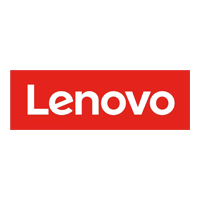
Most versatile and cost-effective blade server solution
The Lenovo ThinkSystem SN550 is a part of Lenovo’s next-generation line of server solutions tailored for the ever-evolving needs of modern data centers. As a blade server, the SN550 emphasizes efficiency, density, and performance. The V2 is an improvement over the previous iteration with more advanced processing and memory capabilities.
Crafted to seamlessly integrate into Lenovo’s ThinkSystem Blade Enclosure, the SN550 is a proof to Lenovo’s focus on adaptability, providing a scalable solution that can handle diverse workloads, from cloud computing to critical database operations.
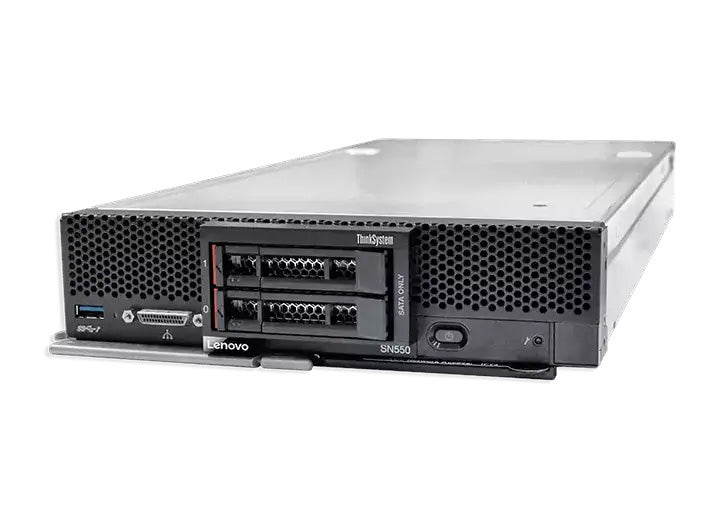
| Pros | Cons |
|---|---|
| Supports the latest Intel Xeon Scalable processors, ensuring high-speed performance | As a blade server, it requires a specific ThinkSystem Blade Enclosure, which might limit its versatility in diverse setups. |
| Crafted with power efficiency in mind, leading to potential savings in operational costs. | Due to its advanced features, the upfront investment might be higher than traditional servers. |
| Incorporates Lenovo’s XClarity Controller, simplifying server management and monitoring. |

Most flexible and scalable blade server solution
The Dell PowerEdge FX2 Chassis exemplifies Dell’s commitment to modularity and high-density computing. As a cornerstone of the PowerEdge FX series, the FX2 Chassis is not just a housing unit but an innovative convergence of server, storage, and networking into a single, compact, and scalable platform.
It’s designed to swiftly adapt to the shifting demands of the modern data center, accommodating a variety of workloads and offering flexibility that few chassis solutions can match.
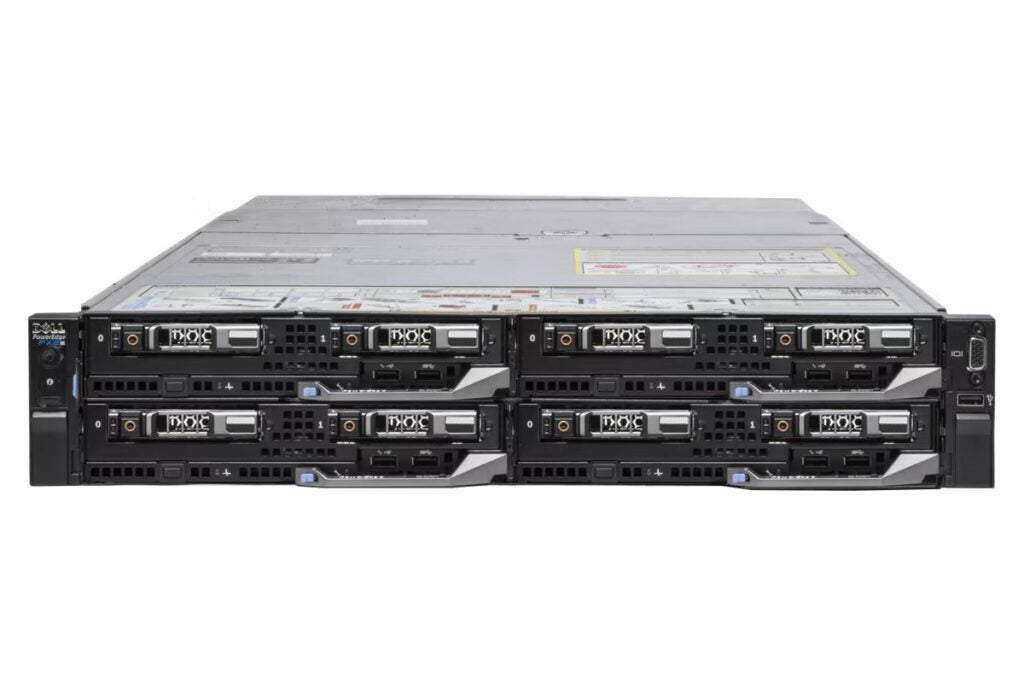
| Pros | Cons |
|---|---|
| The chassis is designed to support various compute, storage, and networking modules, allowing for tailored configurations. | While versatile, it’s reliant on specific Dell modules, which might limit flexibility if not already invested in Dell’s ecosystem. |
| The FX2 packs significant power into a 2U space, optimizing data center real estate. | Given the high density, there could be heightened cooling requirements, especially when fully populated. |
| Incorporates Dell’s OpenManage systems management, enabling streamlined administration across the FX portfolio. |
Blade servers include many of the same features as other server types, such as rack servers and tower servers, in terms of hardware performance — such as processing, memory, and storage — and software functionality — such as manageability and security. But blade servers also stand out from the pack for their enhanced modularity over many other server types.
A blade server’s hardware performance is a critical component that determines its efficiency, speed, and overall capability. Here’s a closer look at some of the primary hardware attributes that play pivotal roles in the operation of blade servers:
The heart and soul of any server, the processor (or CPU) in blade servers is designed for high performance and multi-core processing. Many modern blade servers support multiple processors, allowing them to handle a large number of simultaneous tasks.
Leading manufacturers often opt for the latest generation of CPUs from giants like Intel and AMD to ensure peak performance.
Blade servers typically support a high density of RAM to handle vast datasets and run complex applications smoothly. The ability to have ample memory is crucial for tasks like virtualization, where multiple virtual machines may operate simultaneously.
Advanced blade servers offer flexible memory configurations to cater to varying needs.
Blade servers provide diverse storage solutions, from traditional hard disk drives (HDDs) to solid-state drives (SSDs) that offer faster read/write speeds. Some models even support NVMe drives for ultra-fast data access.
The modular nature of blade servers allows for easy expansion of storage capacity as required.
Blade servers come equipped with multiple high-speed networking interfaces. These can range from Gigabit Ethernet ports to more advanced options like 10GbE, 25GbE, or even 100GbE for high-throughput tasks.
Additionally, many blade servers support Fibre Channel interfaces for SAN connectivity.
One of the standout features of blade servers is their power efficiency. Designed to operate on shared power supplies within a chassis, blade servers can dynamically adjust power consumption based on workload.
This not only ensures optimal performance but also leads to significant energy savings. Advanced power management features in modern blade servers further enhance their green credentials.
While the hardware components of blade servers are pivotal in determining their performance metrics, the software functionalities they offer are equally important. These software features facilitate streamlined operations, robust security, and efficient management, allowing organizations to harness the full potential of their blade infrastructure.
Integral to the operation of blade servers is the management software. This software provides administrators with a unified dashboard to monitor, configure, and manage all the blades within a chassis.
Features might include performance monitoring, hardware inventory, firmware updates, and system diagnostics. With an intuitive user interface, administrators can swiftly address issues, deploy new blades, and optimize performance.
Security is a non-negotiable in the modern enterprise, and blade servers are no exception. Modern blade servers come equipped with advanced security features like hardware-based encryption, secure boot processes, and Trusted Platform Module (TPM) support.
Additionally, integrated firewalls and intrusion detection systems can safeguard against malicious attacks.
Data protection is a cornerstone of any IT operation. Blade servers often incorporate built-in backup and recovery solutions, allowing for automated data backups, swift data recovery, and system restoration. This ensures business continuity and minimizes downtime in case of any unforeseen events.
Blade servers are renowned for their prowess in virtualization. With support for leading virtualization platforms like VMware, Microsoft Azure, and KVM, these servers can host multiple virtual machines (VMs) efficiently.
This capability not only optimizes hardware utilization but also offers flexibility in deploying varied applications and services.
Given the often decentralized nature of businesses today, remote management capabilities are a boon. Blade servers typically feature out-of-band management tools, allowing administrators to access and manage servers remotely, regardless of the server’s operating state.
This is especially valuable for organizations with data centers spread across multiple locations.
The decision to implement blade servers in an organization’s IT infrastructure is not solely a technological one; it also has profound business implications. The modular features and benefits unique to blade servers can translate directly into tangible business advantages. Here’s how:
One of the primary strengths of blade servers is their innate scalability. As a business grows and its computing needs expand, adding more blades to an existing chassis is both cost-effective and time-efficient.
This ensures that organizations can swiftly scale up their IT resources in tandem with their growth, avoiding potential operational bottlenecks.
Downtime, whether planned or unplanned, can be detrimental to a business’s bottom line. Blade servers often support hot-swapping, where components like drives or even entire blades can be replaced without shutting down the system.
This means maintenance or upgrades can be conducted with minimal disruption, ensuring continuous business operations.
Energy costs are a significant expenditure for many organizations. Blade servers, with their consolidated design and shared power and cooling resources, tend to be more energy-efficient than traditional rack servers.
This not only leads to lower operational costs but also positions the business as environmentally conscious.
A robust support structure can make all the difference in swiftly resolving potential issues. Leading blade server manufacturers typically offer comprehensive support packages, including 24/7 technical support, extended warranties, and on-site repair services.
Such support ensures that businesses can rely on their infrastructure without concerns of prolonged downtime or unresolved technical challenges.
As IT operations scale and become increasingly complex, broad compatibility and easy integration can become massive time savers. Blade servers are designed with this in mind, often supporting a wide range of operating systems, applications, and hardware peripherals.
This ensures seamless integration with existing IT environments and facilitates the adoption of new technologies as they emerge.
Still, it’s important to remember that, like most servers, blade chassis may not be compatible with other manufacturers’ hardware, so vendor lock-in is still a concern.
Selecting the right blade server for your organization is a task that combines technical requirements with business objectives. With myriad options in the market, each boasting unique features and capabilities, the decision-making process can seem daunting.
However, by focusing on a few key considerations, businesses can pinpoint the server model that aligns seamlessly with their needs. Here’s a guide to help you navigate this decision:
Begin by evaluating your present IT infrastructure. What are your current pain points? What do you expect your future computing needs to be? This baseline assessment will provide clarity on the specifications and capabilities you should prioritize.
Business growth is aspirational for most organizations. Choosing a blade server that offers easy scalability ensures you can accommodate future growth without significant infrastructural overhauls.
Dive into the technical specifications. Look at the processor types, memory capacity, storage options, and connectivity capabilities. Ensure the hardware aligns with the applications and tasks your business routinely runs.
In an era of rampant cyberthreats, security is paramount. Opt for blade servers that offer advanced security features, including hardware-based encryption, secure boot processes, and integrated firewalls.
Not all blade server manufacturers are created equal. Look into reviews, customer testimonials, and industry accolades to gauge the reliability and performance of a vendor’s products.
While the upfront cost is a factor, it’s vital to consider the TCO. This includes the initial investment, energy consumption costs, maintenance expenses, and potential upgrade costs. It may be worth a greater upfront investment in order to save costs in the long run.
Ensure the blade server you choose integrates seamlessly with your existing IT environment. This includes compatibility with software applications, networking equipment, and storage solutions.
Opt for vendors that offer robust support services, including round-the-clock technical support, extensive warranties, and regular software updates.
Given the rising energy costs and a global push towards sustainability, choosing energy-efficient blade servers can result in significant savings and bolster your organization’s green credentials.
Some blade server brands have vast communities and ecosystems, which can be invaluable. They offer forums, guides, and resources that can assist in troubleshooting, optimization, and even networking with other businesses.
In our quest to identify the best blade servers for 2023, we employed a comprehensive and rigorous evaluation methodology. We believe that to truly gauge the effectiveness and relevance of a blade server, one must examine it from various angles, encompassing its technical prowess, software capabilities, business implications, and cost considerations.
Here’s a breakdown of how we evaluated the servers based on different criteria, along with the weightage given to each:
The foundational element of any server is its hardware. Our evaluation laid significant emphasis on this, accounting for 30% of the total score.
Criteria winners: Cisco UCS B200 M5, Lenovo ThinkSystem SN550, HPE ProLiant BL460c
Equally essential are the software capabilities a blade server brings to the table. This also constituted 30% of our overall evaluation.
Criteria winners: HPE ProLiant BL460c, Cisco UCS B200 M5
How a blade server influences business operations is a major factor in its long-term success, which is why this criterion had a 20% weight.
Criteria winners: HPE ProLiant BL460c, Cisco UCS B200 M5
Last but by no means least, the cost considerations, availability, and ease of communication with the vendor played a role in our evaluations, contributing to 20% of the overall score.
Criteria winners: Dell PowerEdge FX2 Chassis, HPE ProLiant BL460c, Lenovo ThinkSystem SN550
Blade servers are compact server units that slide into a standardized enclosure, or chassis, along with other blades. They are designed to optimize space, power, and cooling by sharing resources like power supplies and fans across multiple blades in a single chassis.
Traditional rack-mounted servers, on the other hand, are standalone units, each with its own set of resources. While rack servers take up more space and often have more cabling, they can operate independently of others in the same rack. Here is our guide to the best rack servers.
Determining the best blade server for your organization involves a combination of understanding your current IT infrastructure, future growth plans, application workloads, and budgetary constraints.
Begin by assessing your existing and anticipated computing needs. Consider factors such as the required processing power, memory, storage, and networking capabilities.
Also, evaluate other features like security, management software, vendor support, and scalability. It can be beneficial to work with an IT consultant or leverage vendor assessments to ensure you choose a solution that aligns with your organization’s goals.
Yes, many blade server vendors prioritize security and offer advanced features to safeguard data and operations. These features can include hardware-based encryption, secure boot processes, trusted platform modules (TPMs), intrusion detection systems, and integrated firewalls.
When selecting a blade server, it’s crucial to inquire about its security capabilities, ensuring they meet industry standards and align with your organization’s security requirements.
Blade servers, with their compact design and integrated resource management, stand out as a prime choice for organizations seeking to optimize their IT infrastructures. Their inherent ability to save space, reduce energy consumption, and streamline management processes makes them a preferred choice for many modern enterprises.
However, as with any investment, the key lies in understanding your organization’s unique needs and growth trajectories. By considering factors like hardware capabilities, software functionalities, security requirements, and vendor support, businesses can ensure they select a blade server that not only meets their current requirements but also positions them for future success.
Server hardware is the foundation of your data center, but don’t forget the software. Here are the best server management software and the best server security tools to keep your business running smoothly.


Allan is based in Quezon City, Philippines, with over a decade of experience in the ever-evolving IT landscape. With a degree in Computer Science and another in Information Science plus eight years freelancing for B2B and tech enterprises, Allan is proud to marry first-hand skills with research-based storytelling to make the most complex topics understandable and accessible. When not navigating the realms of servers, SaaS, networking, web development, and other digital technologies, he finds solace in the imaginative worlds crafted by authors like Robert Jordan and J.R.R. Tolkien.
Property of TechnologyAdvice. © 2025 TechnologyAdvice. All Rights Reserved
Advertiser Disclosure: Some of the products that appear on this site are from companies from which TechnologyAdvice receives compensation. This compensation may impact how and where products appear on this site including, for example, the order in which they appear. TechnologyAdvice does not include all companies or all types of products available in the marketplace.